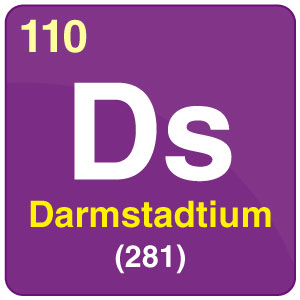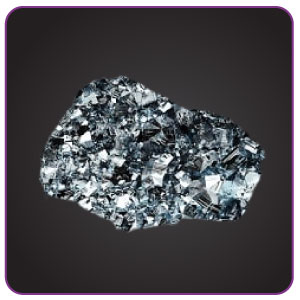Darmstadtium

| Symbol | Ds |
| Atomic Number | 110 |
| Atomic Mass | 281 g.mol -1 |
| Discovered by | Gesellschaft für Schwerionenforschung(1994) |

Chemical Properties
| Group | 10 | Melting point | Unknown |
| Period | 7 | Boiling point | Unknown |
| Block | d | Density (g cm−3) | Unknown |
| Atomic number | 110 | Relative atomic mass | [281] |
| State at 20°C | Solid | Key isotopes | 281Ds |
| Electron configuration | [Rn] 5f146d87s2 | CAS number | 54083-77-1 |
| ChemSpider ID | – | ChemSpider is a free chemical structure database. | |
What is Darmstadtium?
- Darmstadtium (Ds) is a synthetic chemical element with atomic number 110 and symbol Ds in the Periodic Table.
- It was first created by the Gesellschaft für Schwerionenforschung ( Society for Heavy Ion Research ) in the year 1994. Credit for the discovery goes to Sigurd Hofmann, Peter Armbruster, and Gottfried Münzenberg.
- The discovery was near a City called Darmstadt, Germany and this is the reason it was named Darmstadtium.
Uses of Darmstadtium
- Presently, there are no uses or applications of Darmstadtium. It is only used for research purposes. Biological use is yet to be known.
Properties of Darmstadtium
- It is a man-made element of which only a few atoms have ever been created. It was created in a heavy ion accelerator using atoms of lead & nickel. Thus, most of its properties have been predicted.
- It is a d-block transactinide element in the periodic table and a member of the 7th period which is placed in group 10 elements.
- It was predicted that this element contains similar properties as that of its homologues, palladium, nickel, and platinum.
- The element has no naturally occurring or stable isotopes. The most stable known isotope is darmstadtium whose life is expected be approximately 10 seconds.
- Darmstadtium is expected to be solid at room temperature and a very heavy metal with a density of 34.8 g/cm3
Environment Effects of Darmstadtium
- These elements have very unstable nuclei and it does not occur naturally in nature. Due to its short life, it is not harmful to the environment.

Comments